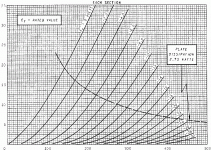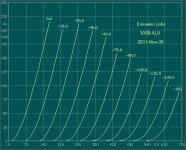Just for fun, I traced some curves for the NTE451 JFET that show the effect of parallel feedback. It indeed works as advertized (on the curve tracer).
A characteristic of real triodes I do not see in any of those curve sets:
Curves on the right side tend to "lean over to the right", is not happening.
Smoking Amp had once hypothesized that a real triode is many in parallel
with slightly different parameters, especially cutoff. So a triode is average
of a set that diminishes in size. Skewing the average, "leaning to the right".
I could graph a pretty realistic lean out of 4 carefully selected non-leaning
Schade curves. It doesn't take an infinitely huge set to find some lean.
Unless your load line is all over the map (like maybe a real loudspeaker),
I don't think you will hear much lean-over driving a well behaved resistor.
It might only make sense in an output stage for mimicry of triode sound.
How much you want to nit-pick how a solid state triode should behave
like the real thing, or like an ideal thing? I found math of a diminishing
set interesting, no intentions of building it...
Last edited:
You don't find so much lean in triodes of flat parallel construction.
But in sloppy triode where plate wraps round shape of convenience,
you got lots of variation in the internal set. You get a lean-over...
Unlike perfectly Schaded fake curves, they diverge at higher current
(or crunch together at lower current) and not at all parallel anywhere.
This 12AU7 shows some lean-over...
But in sloppy triode where plate wraps round shape of convenience,
you got lots of variation in the internal set. You get a lean-over...
Unlike perfectly Schaded fake curves, they diverge at higher current
(or crunch together at lower current) and not at all parallel anywhere.
This 12AU7 shows some lean-over...
Attachments
Last edited:
avincenty and kenpeter: Thank you for your valuable comments. You are in touch with the various approaches of Audio Engineers, and DIYers to coerce electrons moving in solid state devices to mimick those in triodes. Fortunately, the power of the natural law "Structure -Property" Relationships always dominates as kenpeter alluded to.
Please go to post # 58 in the Thread [Pass labs Forum] by wrenchone entitled partly" L'Fake .... " In it I describe a schematic of a working amp [also attached here] which [IMHO] satisfies the requirements of Schade feedback; except that I used a bjt current source amp instead of a power FET. I am not making any claims about it sounding like a triode, a SIT or other device. Just sharing information; which I hope maybe useful to you.
Brgds.
Please go to post # 58 in the Thread [Pass labs Forum] by wrenchone entitled partly" L'Fake .... " In it I describe a schematic of a working amp [also attached here] which [IMHO] satisfies the requirements of Schade feedback; except that I used a bjt current source amp instead of a power FET. I am not making any claims about it sounding like a triode, a SIT or other device. Just sharing information; which I hope maybe useful to you.
Brgds.
Attachments
any news ?Are there a schematic available in the meantime?
Measuring results are to find here:
EAR/Yoshino M100A monoblock power amplifier Measurements | Stereophile.com
and the listening test results here:
EAR/Yoshino M100A monoblock power amplifier | Stereophile.com
Started this thread 15 years ago. After having taken a pause from electronics for more than 10 years I found Zenductor and was impressed by it´s simplicity, but found it lacked gain. Inspired by both Zenductor and Michael J. Kosters Schadeode, this is what came up. It sims OK, but I will have to try it IRL with a Hammond 193 I already have in my stash.
The input device has a little to much input capacitance, but there are surely better depletion MOSFET´s nowadays, also the output device might be exchanged for something newer. Any recommendations?

The input device has a little to much input capacitance, but there are surely better depletion MOSFET´s nowadays, also the output device might be exchanged for something newer. Any recommendations?
Last edited:
Until recently I would have recommended the FQH44N10 in place of the IRFP250N. Sadly that part is no longer being manufactured and is difficult to source. Fortunately my recent experiments with the F6 have turned up another very good part, the IXTQ75N10P. I have been very happy with the sound of my F6 with the IXTQ parts. If you are willing to boost the supply voltage of your creation to 24V, the higher transconductance Mosfets will perform.
There is another one to look at, which is the IXTQ36N30P. This one looks good on paper, but I haven't had a chance to listen to a set yet. I'm building an Aleph J with the FQH44N10 first.
There is another one to look at, which is the IXTQ36N30P. This one looks good on paper, but I haven't had a chance to listen to a set yet. I'm building an Aleph J with the FQH44N10 first.
- Home
- Amplifiers
- Pass Labs
- O.H. Schade (1938) meets mosFET

